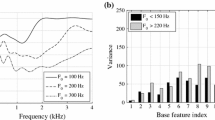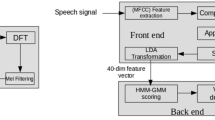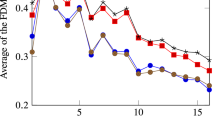Abstract
The work presented in this paper aims at enhancing the recognition performance of zero-shot children’s speech recognition task through frame-level concatenation of two complementary front-end acoustic features. The acoustic features chosen are TANDEM-STRAIGHT-based Mel-frequency cepstral coefficients (TS-MFCC) and Gamma-tone frequency cepstral coefficients (GFCC). The GFCC model the cochlear response of the human auditory system. The MFCC features, on the other hand, model the human pitch perception. Therefore, the GFCC and TS-MFCC features capture the acoustic information differently and that too with very low correlation. Consequently, concatenation of TS-MFCC and GFCC feature vectors helps in modeling complementary and a wider range of relevant acoustic information. This, in turn, enhances the recognition performance significantly. The experimental evaluations presented in this paper show that a relative reduction of nearly \(12\%\) is achieved by feature concatenation.
Access this chapter
Tax calculation will be finalised at checkout
Purchases are for personal use only
Similar content being viewed by others
References
Batliner, A., et al.: The PF_STAR children’s speech corpus. In: Proceedings of Interspeech, pp. 2761–2764 (2005)
Cheng, O., Abdulla, W., Salcic, Z.: Performance evaluation of front-end algorithms for robust speech recognition. In: Proceedings of the Eighth International Symposium on Signal Processing and Its Applications, 2005, vol. 2, pp. 711–714 (2005). https://doi.org/10.1109/ISSPA.2005.1581037
Damskägg, E.P., Välimäki, V.: Audio time stretching using fuzzy classification of spectral bins. Appl. Sci. 7(12), 1293 (2017). https://doi.org/10.3390/app7121293
Gerosa, M., Giuliani, D., Brugnara, F.: Acoustic variability and automatic recognition of children’s speech. Speech Commun. 49(10–11), 847–860 (2007)
Graves, A., Jaitly, N., Mohamed, A.R.: Hybrid speech recognition with deep bidirectional LSTM. In: 2013 IEEE Workshop on Automatic Speech Recognition and Understanding, pp. 273–278. IEEE (2013)
Graves, A., Mohamed, A.R., Hinton, G.: Speech recognition with deep recurrent neural networks. In: 2013 IEEE International Conference on Acoustics, Speech and Signal Processing, pp. 6645–6649. IEEE (2013)
Hinton, G.E.: Deep neural networks for acoustic modeling in speech recognition. Signal Process. Maga. 29(6), 82–97 (2012)
Kumar, V., Kumar, A., Shahnawazuddin, S.: Creating robust children’s ASR system in zero-resource condition through out-of-domain data augmentation. Circuits Syst. Signal Process. 41(4), 2205–2220 (2022). https://doi.org/10.1007/s00034-021-01885-5
Kumar Kathania, H., Reddy Kadiri, S., Alku, P., Kurimo, M.: Study of formant modification for children ASR. In: ICASSP 2020–2020 IEEE International Conference on Acoustics, Speech and Signal Processing (ICASSP), pp. 7429–7433 (2020). https://doi.org/10.1109/ICASSP40776.2020.9053334
Lee, L., Rose, R.: A frequency warping approach to speaker normalization. IEEE Trans. Speech Audio Process. 6(1), 49–60 (1998)
Lee, S., Potamianos, A., Narayanan, S.: Acoustics of children’s speech: developmental changes of temporal and spectral parameters. J. Acoust. Soc. Am. 105(3), 1455–1468 (1999)
Makhoul, J.: Linear prediction: a tutorial review. Proc. IEEE 63(4), 561–580 (1975). https://doi.org/10.1109/PROC.1975.9792
Morise, M., Takahashi, T., Kawahara, H., Irino, T.: Power spectrum estimation method for periodic signals virtually irrespective to time window position. Trans. IEICE 90(12), 3265–3267 (2007)
Patterson, R.: Auditory filters and excitation patterns as representations of frequency resolution. In: Frequency Selectivity in Hearing (1986)
Peddinti, V., Povey, D., Khudanpur, S.: A time delay neural network architecture for efficient modeling of long temporal contexts. In: Proceedings of Interspeech (2015)
Povey, D., et al.: The Kaldi Speech recognition toolkit. In: Proceedings of ASRU (2011)
Povey, D., et al.: Purely sequence-trained neural networks for ASR based on lattice-free MMI. In: Proceedings of Interspeech, pp. 2751–2755 (2016)
Robinson, T., Fransen, J., Pye, D., Foote, J., Renals, S.: WSJCAM0: a British English speech corpus for large vocabulary continuous speech recognition. In: Proceedings of ICASSP, vol. 1, pp. 81–84 (1995). https://doi.org/10.1109/ICASSP.1995.479278
Russell, M., D’Arcy, S.: Challenges for computer recognition of children’s speech. In: Proceedings of Speech and Language Technologies in Education (SLaTE) (2007)
Sainath, T.N., Vinyals, O., Senior, A., Sak, H.: Convolutional, long short-term memory, fully connected deep neural networks. In: 2015 IEEE International Conference on Acoustics, Speech and Signal Processing (ICASSP), pp. 4580–4584 (2015). https://doi.org/10.1109/ICASSP.2015.7178838
Schluter, R., Bezrukov, I., Wagner, H., Ney, H.: Gammatone features and feature combination for large vocabulary speech recognition. In: Proceedings of ICASSP, vol. 4, pp. IV-649–IV-652 (2007). https://doi.org/10.1109/ICASSP.2007.366996
Serizel, R., Giuliani, D.: Vocal tract length normalisation approaches to DNN-based children’s and adults’ speech recognition. In: Proceedings of Spoken Language Technology Workshop (SLT), pp. 135–140 (2014)
Shahnawazuddin, S., Adiga, N., Kathania, H.K., Sai, B.T.: Creating speaker independent ASR system through prosody modification based data augmentation. Pattern Recogn. Lett. 131, 213–218 (2020). https://doi.org/10.1016/j.patrec.2019.12.019
Shahnawazuddin, S., Adiga, N., Kumar, K., Poddar, A., Ahmad, W.: Voice conversion based data augmentation to improve children’s speech recognition in limited data scenario. In: Proceedings of Interspeech, pp. 4382–4386 (2020). https://doi.org/10.21437/Interspeech.2020-1112
Shahnawazuddin, S., Adiga, N., Kathania, H.K., Pradhan, G., Sinha, R.: Studying the role of pitch-adaptive spectral estimation and speaking-rate normalization in automatic speech recognition. Digital Signal Process. 79, 142–151 (2018)
Shahnawazuddin, S., Adiga, N., Kathania, H.K.: Effect of prosody modification on children’s ASR. IEEE Signal Process. Lett. 24(11), 1749–1753 (2017)
Shao, Y., Jin, Z., Wang, D., Srinivasan, S.: An auditory-based feature for robust speech recognition. In: Proceedings of ICASSP, pp. 4625–4628 (2009). https://doi.org/10.1109/ICASSP.2009.4960661
Shao, Y., Wang, D.: Robust speaker identification using auditory features and computational auditory scene analysis. In: 2008 IEEE International Conference on Acoustics, Speech and Signal Processing, pp. 1589–1592 (2008). https://doi.org/10.1109/ICASSP.2008.4517928
Valero, X., Alias, F.: Gammatone cepstral coefficients: biologically inspired features for non-speech audio classification. IEEE Trans. Multimedia 14(6), 1684–1689 (2012). https://doi.org/10.1109/TMM.2012.2199972
Waibel, A., Hanazawa, T., Hinton, G., Shikano, K., Lang, K.: Phoneme recognition using time-delay neural networks. IEEE Trans. Acoust. Speech Signal Process. 37(3), 328–339 (1989). https://doi.org/10.1109/29.21701
Author information
Authors and Affiliations
Corresponding author
Editor information
Editors and Affiliations
Rights and permissions
Copyright information
© 2023 The Author(s), under exclusive license to Springer Nature Switzerland AG
About this paper
Cite this paper
Ankita, Shambhavi, Shahnawazuddin, S. (2023). Studying the Effect of Frame-Level Concatenation of GFCC and TS-MFCC Features on Zero-Shot Children’s ASR. In: Karpov, A., Samudravijaya, K., Deepak, K.T., Hegde, R.M., Agrawal, S.S., Prasanna, S.R.M. (eds) Speech and Computer. SPECOM 2023. Lecture Notes in Computer Science(), vol 14339. Springer, Cham. https://doi.org/10.1007/978-3-031-48312-7_11
Download citation
DOI: https://doi.org/10.1007/978-3-031-48312-7_11
Published:
Publisher Name: Springer, Cham
Print ISBN: 978-3-031-48311-0
Online ISBN: 978-3-031-48312-7
eBook Packages: Computer ScienceComputer Science (R0)




